Fibonacci quasicrystal
A Fibonacci crystal or quasicrystal is a model used to study systems with aperiodic structure. Both names are acceptable as a 'Fibonacci crystal' denotes a quasicrystal and a 'Fibonacci' quasicrystal is a specific type of quasicrystal. Fibonacci 'chains' or 'lattices' are other synonyms used with regard to the dimensionality of the model.[1] While it is used mostly as a theoretical construct, physical models are also implemented for empirical checks. Most of its applications pertain to various areas of solid state physics.

The mathematical properties of the Fibonacci word and related topics are well researched and readily applied in such studies. The elements of a Fibonacci crystal structure are arranged in one or more spatial dimensions according to the sequence given by the Fibonacci word. The Fourier transform of such arrangements consists of discrete values, which is the defining property for crystals. In an algebraic form the sequence is expressed with a matrix whose eigenvalues are Pisot numbers. This feature guarantees that its Fourier transform is discrete. Material waves with appropriate length would interfere constructively when interacting with a Fibonacci structured physical system. For instance, when submitted to X-rays, a Fibonacci quasicrystal would produce Bragg peaks. Other features describing media behaviour such as damping, transmitivity, etc. can be evidenced on Fibonacci models.[2]
The Fibonacci-based constructions are an obvious example of quasicrystals that do not possess a 'forbidden symmetry'. Their diffraction pattern would be of a square type with the intensities arranged in a fractal pattern.[3]
References
- ↑ Searching database of physical papers reveals that 'Fibonacci chain' is the most frequently used; for instance more than 150 such items are found in Arxiv and just a few dozen other appelations.
- ↑ Dharma-wardana M. W. C. and al., Raman scattering in Fibonacci superlattices , Phys.Rev.Lett. 58 (1987) 1761, doi 10.1103/PhysRevLett.58.1761
- ↑ Lifshitz R., The square Fibonacci tiling,J. of Alloys and Compounds 342 (2002) 186–190